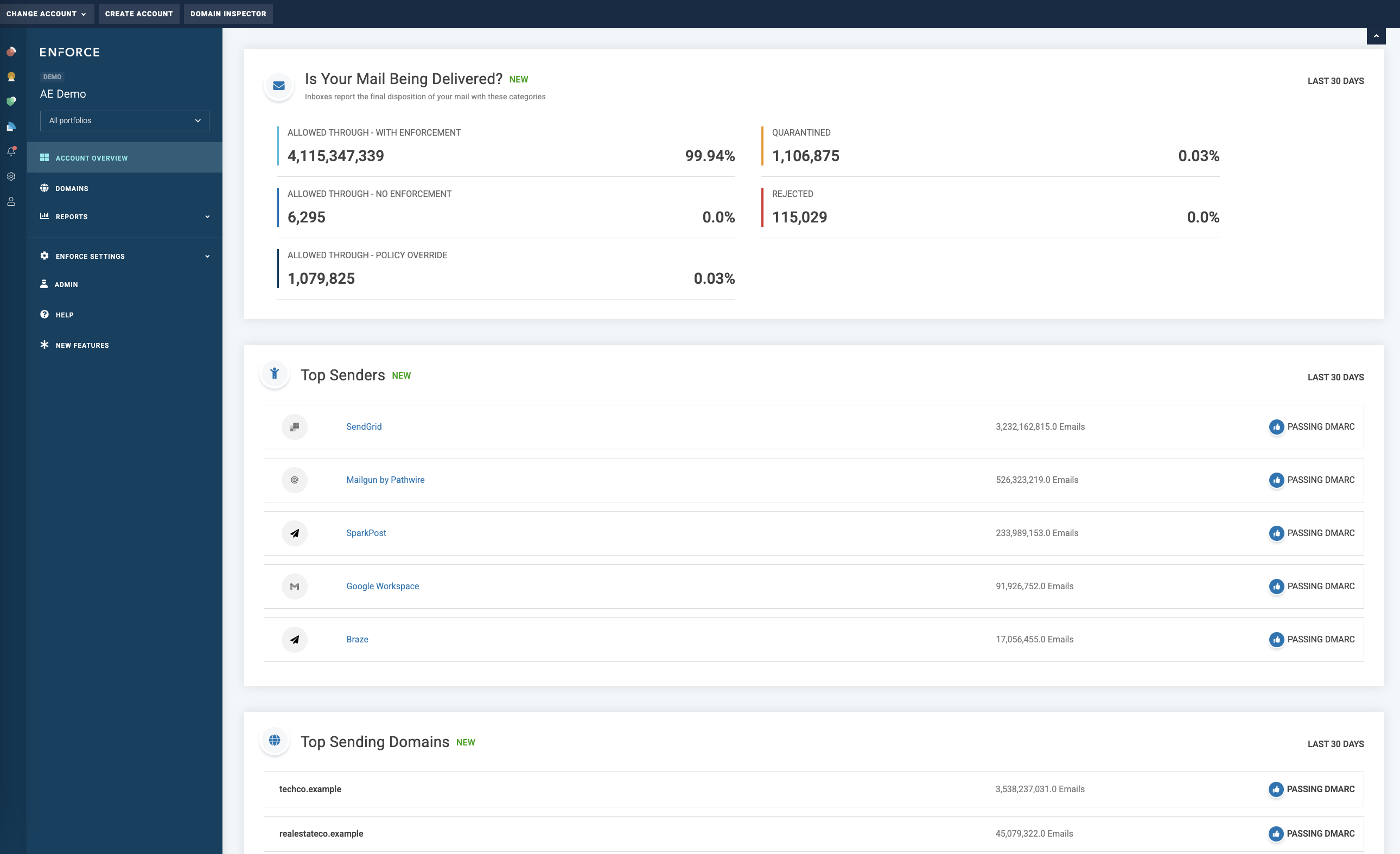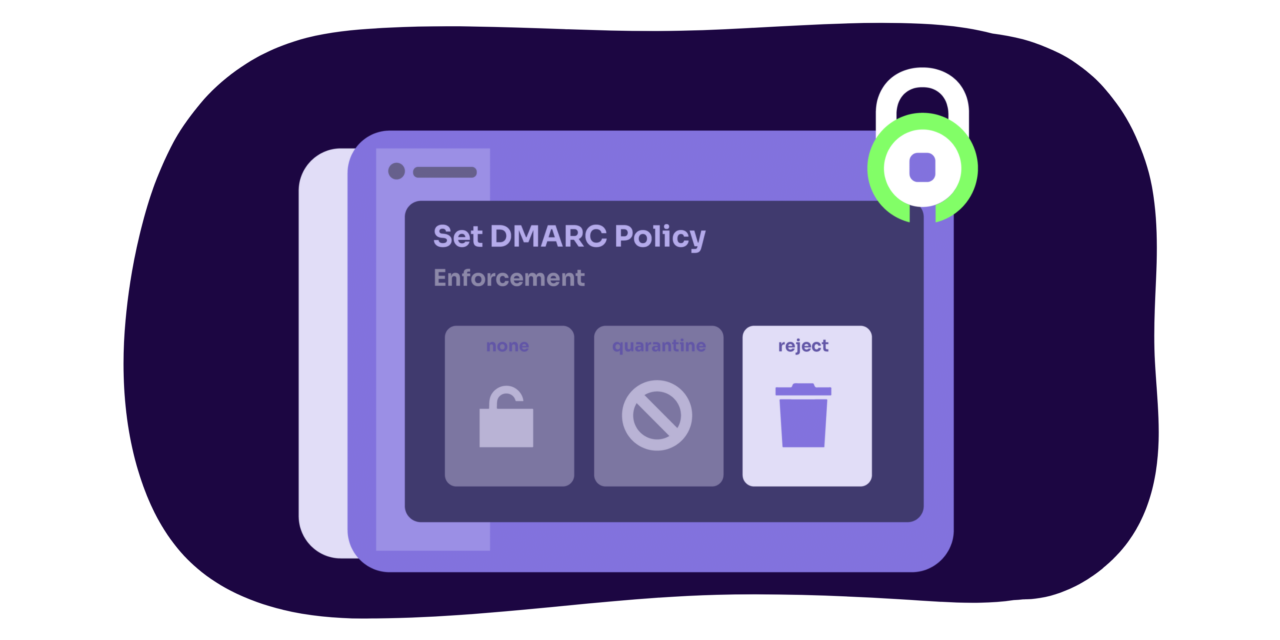Regarding visibility, we believe that your data is only as good as the format in which it’s presented.
As the first application built on the Valimail Identity-Driven Email Anti-impersonation (IDEA)™ platform, Valimail Enforce was purpose-built to make the journey to DMARC enforcement drastically easier through true automation and visibility.
Many of Valimail’s customers send billions of emails a month, so you can imagine the wealth of available data. The Valimail Enforce reporting suite makes it easy to consume and extract actionable intelligence from massive amounts of DMARC data — without touching any PII. These reporting tools make Valimail an indispensable tool for uncovering sending trends and accelerating your path to enforcement.
Here’s a snapshot of the reporting tools we provide to our customers.

Global View of Suspicious Senders
The first thing you’ll notice in the Enforce dashboard is a global view of all malicious senders impersonating your organization’s domain.
Here, you get a holistic look at suspicious senders by country, giving you a firm starting point for threat detection and protection.
Four-Dimensional Drill-Down Reporting
We allow you to slice and dice your data across multiple axes, including domain, sender, day, and country. This provides deep insights into your email authentication effort, especially in multi-domain environments.
Suppose you’re managing email authentication across a large organization that owns hundreds of domains and subdomains. The ability to automatically identify and pinpoint third-party senders (and the sending volume associated with each one) across specific domains and countries becomes an extremely powerful tool in controlling shadow IT and improving compliance.
This cross-domain reporting functionality is also valuable in providing insight and diagnosing sending problems. For instance, you can drill down into a particular service (like Mailchimp) and see all the domains using it. That could uncover problems limited to a specific domain for a given service.
Visualizing Your Path to Authentication
The Email Disposition report provides a granular look at various delivery statuses in a given date range. The value here is in knowing what has and hasn’t been enforced across your domains, which can help you get closer to enabling DMARC enforcement.
- The “Allowed Through – No Enforcement” status shows the number of emails sent from domains you own that are not at DMARC enforcement. All emails represented in this status get through to the inboxes they’re sent to, regardless of which service sent them. While that’s not a problem for legitimate emails you send, it represents a major risk of exact-domain impersonation attacks. Once you reach enforcement, giving you full control and protection over outbound email from your domains, this number will be zero.
- The “Allowed Through – Policy Override” status shows emails that failed DMARC authentication but were allowed through due to an override. An override is a decision by the receiver to ignore the DMARC policy. A good example is Gmail overriding a failed DMARC alignment to accept a forwarded group email that it’s certain is actually non-malicious.
- The “Allowed Through—With Enforcement” status shows emails that passed DMARC authentication and were sent from domains at enforcement. This is the number of emails that were successfully delivered after passing DMARC authentication.
- The “Quarantined” status represents part of the message volume from domains at enforcement, showing the number of emails marked as spam by the end user’s email provider due to failing DMARC authentication.
- The “Rejected” status also represents a part of the enforced domain message volume, showing the number of emails that failed DMARC authentication and never reached the inbox.

Valimail DMARC Reporting vs. Traditional Methods
Your approach to DMARC reporting can significantly impact its effectiveness. Here, we compare Valimail’s innovative approach to traditional DMARC reporting methods, highlighting how Valimail simplifies and enhances the process.
Traditional DMARC reporting methods
- Manual Analysis: Traditionally, DMARC reporting involves manually sifting through XML reports. These reports are often complex and voluminous, making it challenging to extract actionable insights.
- Limited Visualization: Conventional methods typically lack sophisticated visualization tools, making it difficult to identify trends and patterns in email authentication data.
- Resource-Intensive: Manual DMARC management requires significant IT resources and expertise, often leading to increased operational costs and time investment.
- Reactive Approach: Traditional reporting is often reactive, with organizations responding to issues after they have impacted email deliverability or security.
Valimail’s approach
- Automated Analysis: Valimail Enforce automates the analysis of DMARC data, transforming raw XML reports into easy-to-understand insights. This automation significantly reduces the time and expertise required to manage DMARC.
- Advanced Visualization: With Valimail, users can access a user-friendly dashboard with a global view of email traffic and threats. This visualization aids in quickly identifying malicious senders and understanding email authentication trends.
- Efficiency and Cost-Effectiveness: By automating the DMARC reporting process, Valimail reduces the need for extensive IT resources, thereby lowering operational costs and freeing up staff for other critical tasks.
- Proactive Security Posture: Valimail’s approach is inherently proactive. It enables organizations to anticipate and address potential email security issues before they escalate, enhancing overall email protection.
- Cross-Domain Insights: Unlike traditional methods, Valimail offers cross-domain reporting functionality, which is crucial for organizations managing multiple domains. This feature provides a comprehensive view of email authentication efforts across the entire organization.
- Granular Control: Valimail provides detailed reports on email dispositions, allowing users to understand precisely what is happening with their email traffic. This level of detail is instrumental in moving towards full DMARC enforcement.
- User-Friendly Interface: The platform is designed with user experience in mind, making it accessible even to those with limited technical expertise in email security.
- Scalability: Valimail’s solution scales effortlessly with the organization’s growth, handling large volumes of email data without compromising performance.
Get Started With Valimail’s DMARC Reporting Tools
As the world’s only fully automated email authentication solution, Valimail Enforce removes the operational complexity and IT time and expense from the process of deploying and managing DMARC. Valimail’s reporting services provide the granular visibility you need to get your organization to enforcement efficiently and to keep you there for good.
Don’t just take our word for it. IT leaders at Splunk, Yelp, and City National Bank rave about Valimail’s automated approach to DMARC enforcement and our reporting tools.
Ready to get started? Sign up for Valimail Monitor for free to access world-class monitoring to identify all services and sending activity from your domains.
